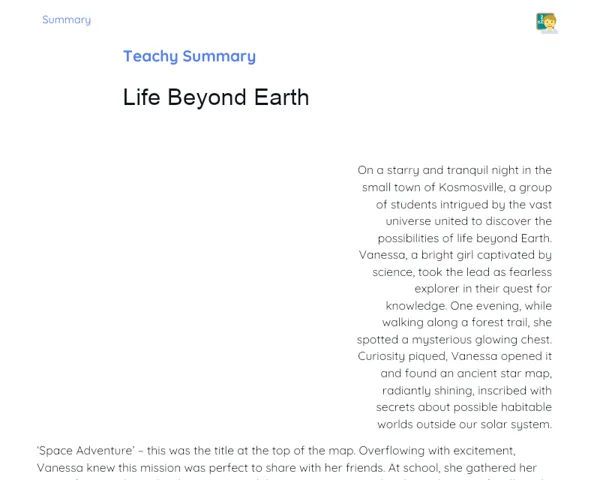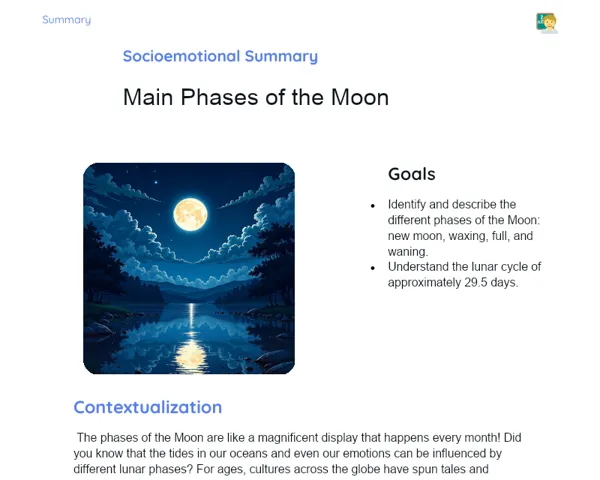Socioemotional Summary Conclusion
Goals
1. Identify and describe the key physical features of plants and animals 🌿🐾
2. Understand the differences and similarities between plants and animals 🧐
Contextualization
Have you ever thought about how plants provide us with the air we breathe and how animals are integral to our everyday lives? 🌱🦁 Familiarising ourselves with these living beings not only helps us appreciate the natural world around us but also teaches us how to care for the environment and the animals we cherish. Are you ready to embark on this interesting journey through the realm of plants and animals together? 🚀
Exercising Your Knowledge
Roots of Plants 🌿
Roots are life-sustaining for plants. They absorb water and nutrients from the soil, which are crucial for the plant's growth and health. Moreover, the roots anchor the plant in the ground, preventing it from being uprooted by wind or rain.
-
Water Absorption: Roots extract water from the soil, essential for photosynthesis and other vital processes.
-
Nourishment: They take in important minerals like nitrogen, phosphorus, and potassium.
-
Anchoring: Roots secure the plant in the soil, ensuring stability.
-
Interaction with the Environment: Roots enable plants to respond to environmental stimuli like gravity and water availability.
Photosynthesis in Leaves 🌞🍃
Leaves are where photosynthesis mainly takes place, which is the process through which plants convert sunlight into energy. This process is fundamental not only for plants but also for all living beings, as it produces the oxygen we breathe.
-
Energy Production: Leaves capture sunlight to produce glucose, a sugar that acts as food for the plant.
-
Oxygen Production: During photosynthesis, plants release oxygen, which is crucial for the respiration of both animals and humans.
-
Leaf Structure: Leaves contain chlorophyll, which absorbs sunlight and gives plants their green hue.
-
Ecological Importance: Through photosynthesis, plants maintain the balance of gases in the atmosphere.
Animal Limbs 🐾
Animal limbs, like legs, wings, and fins, are essential for movement and survival. They serve various functions, from locomotion to capturing food and defending against predators.
-
Locomotion: Limbs such as legs and wings enable animals to move in search of food, shelter, and mates.
-
Exploration: Animals use their limbs to explore their environment, finding resources and sensing potential threats.
-
Defense: Some limbs, like sharp claws or horns, can help animals defend themselves.
-
Adaptation: Limbs differ greatly among species, adapted to the specific environments and lifestyles of the animals.
Key Terms
-
Photosynthesis: The process by which plants utilize sunlight to generate energy.
-
Chlorophyll: The green pigment in plant leaves that absorbs sunlight for photosynthesis.
-
Root: The part of the plant that takes in water and nutrients from the soil and anchors it.
-
Limbs: Structures in animals, such as legs, wings, or fins, used for movement and other functions.
For Reflection
-
How do you think plants' ability to produce oxygen impacts our daily life and the environment? 🌱
-
What emotions arise when you consider the importance of taking care of the animals and plants around us? How can we act in a more responsible manner? 🐾
-
How does understanding the characteristics of plants and animals help us make more informed decisions in our daily lives? 🤔
Important Conclusions
-
We delved into the key characteristics of plants and animals, recognizing the essential roles of roots, leaves, and animal limbs. 🌿🐾
-
We understood the notable differences and similarities between these two groups of living beings, such as their modes of mobility, nutrition, and respiration. 🧐
-
We discussed the significance of photosynthesis performed by plant leaves, a crucial process for oxygen production, and how this affects every living being on Earth. 🌞🍃
Impacts on Society
Understanding the characteristics of plants and animals directly influences our daily lives and communities. Knowing that plants provide oxygen and that animals play important roles in ecosystems helps us appreciate the value of nature conservation. This knowledge empowers us to make responsible choices, such as caring for our gardens and treating our pets with kindness and respect. 🌱🦁
On an emotional level, recognizing the interconnectedness between humans, plants, and animals teaches us important lessons about empathy and the significance of living in harmony with our surroundings. When we form emotional connections with nature, we typically develop a stronger sense of responsibility and respect for all life forms, reinforcing our social consciousness and ability to make thoughtful choices. 🌍❤️
Dealing with Emotions
Let's use the RULER method! At home, take a moment to reflect on a plant or animal that you hold dear. First, recognize the feelings you have for this living being. Understand what triggers those emotions; for instance, a pet might bring you happiness because it offers companionship. Label those feelings accurately. Then, express those emotions creatively through drawing, writing, or sharing with someone else. Finally, regulate your emotions using deep breathing techniques to ensure calmness and clarity in your thoughts. 🧘♂️🧘♀️
Study Tips
-
Create a nature journal: Write down your observations about plants and animals around you, detailing their physical features. ✏️📒
-
Try growing a small plant at home and track its daily growth, noting any changes and characteristics. 🌱
-
Watch documentaries or videos about plants and animals to enhance the knowledge gained in class. 🎥🐾



